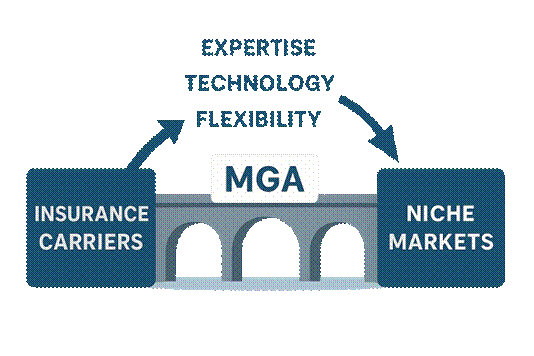The insurance sector has been experiencing substantial disruption and evolution, powered mainly by the rise of Managing General Agents (MGAs). Their unique approach to insurance distribution and underwriting reflects broader industry trends, including a focus on specialization, technological innovation, and agile business models. As MGA-driven premium volumes continue to soar, their prominence underscores a shift in how insurers and agents collaborate across markets—a topic explored in depth by those wanting to learn more about what is an MGA in insurance. These specialized entities operate at the intersection of carrier expertise and market need, providing insurers with access to untapped segments without the heavy lift of building and maintaining complex underwriting infrastructure. MGAs have earned a central role by fostering innovation, filling critical gaps, and delivering tailored products in a way traditional insurers often cannot.
Understanding Managing General Agents
Managing General Agents are licensed intermediaries with delegated authority to perform key insurance functions typically reserved for insurers. This may include underwriting, pricing, binding policies, claims management, and even risk assessment for various types of insurance products, both standard and specialized. Unlike independent agents, who sell insurance, MGAs act on behalf of insurers while bringing their own market knowledge and operational expertise to the table. This enables quick adaptation to regional and niche market trends, a key asset for carriers looking to diversify their risk portfolios or test new products. For example, MGAs have proven instrumental in areas such as cyber insurance, specialty property, and commercial auto—market segments where underwriting expertise and market responsiveness are crucial. By leveraging the MGA model, carriers can pursue innovative product lines without incurring significant organizational overhead or regulatory complexity. MGAs may operate as standalone businesses or as divisions within larger organizations; however, their primary value remains the same: delivering expertise, speed, and flexibility in insurance distribution.

Factors Driving MGA Growth
- Migration of Underwriting Talent: One of the standout trends has been the steady migration of experienced underwriting professionals from large carriers and brokers to MGAs. MGAs often provide these professionals with enhanced autonomy, entrepreneurial freedom, and a direct stake in product outcomes, fueling growth and innovation.
- Adoption of AI and Automation: Modern MGAs lean heavily on artificial intelligence, analytics, and automation to streamline operations, assess risk more accurately, and scale efficiently. Automated application processing, predictive risk modeling, and expedited claims handling have all improved the value proposition of MGAs.
- Expansion of the E&S Market: The growing complexity of business risks—ranging from climate-related threats to new liability exposures—has broadened the Excess and Surplus lines market. MGAs, already equipped to handle such non-standard risks, offer insurers a nimble path to serve high-demand, hard-to-place risks that standard insurers sometimes avoid.
Role of Technology in MGA Expansion
Technology forms the backbone of the modern MGA model, enabling operational efficiency and scalable innovation. Advanced AI-driven tools analyze and interpret massive data sets; for example, risk scoring and claims automation enable MGAs to make quick, informed decisions. This transformation is evident across the insurance industry, where speed and personalization are becoming increasingly essential. Insurtech partnerships have further accelerated MGA growth, connecting these agile companies with digital distribution channels, embedded insurance offerings, and real-time customer engagement strategies. This allows MGAs to outpace legacy carriers in product launches and market penetration while delivering more customer-centric experiences.
Impact on the Insurance Market
- Increased Competition: The entrance of MGAs into new distribution channels and specialized markets means increased competition, which spurs innovation and gives policyholders more choices.
- Specialized Coverage: MGAs have filled crucial voids by designing policies that address emerging risks and the nuanced needs of small business owners, tech startups, gig economy workers, and more.
- Flexibility for Insurers: Insurers benefit from the upstream innovation provided by MGAs, which enables them to rapidly expand their reach without incurring the costs and risks associated with direct market entry. By leveraging MGA expertise, carriers can achieve greater efficiencies and agility while focusing their resources on their core strengths.
Challenges and Risks
- Regulatory Compliance: MGAs operate across multiple states and lines of coverage, necessitating robust compliance mechanisms to keep pace with the diverse requirements of state, federal, and global insurance regulations.
- Alignment of Interests: Ensuring that MGAs’ interests remain closely aligned with those of their underwriting partners is crucial. Misalignment can result in poor underwriting discipline or inefficiencies.
- Market Volatility: Just as MGAs can benefit from rapid market shifts, adverse events—such as catastrophic losses or economic downturns—can also expose vulnerabilities, threatening profitability and growth.
Future Outlook
The future for MGAs looks bright. As insurers and reinsurers seek increased flexibility, cost-efficiency, and access to specialized expertise, MGAs are poised for further expansion. Their proven ability to deploy advanced technology, enter underserved markets, and create customized solutions suggests continued upward momentum. Still, to sustain this growth, MGAs must redouble their efforts on robust governance, regulatory adherence, and strong partnerships with insurers and technology providers.
Conclusion
Managing General Agents have assumed a pivotal role in transforming the insurance industry. By offering insurers speed, flexibility, and deep specialization, MGAs are not only driving innovation but also advancing risk solutions for modern challenges. Their continued success rests on their ability to manage risk, remain compliant, and thoughtfully partner with insurers in a rapidly evolving market environment.




